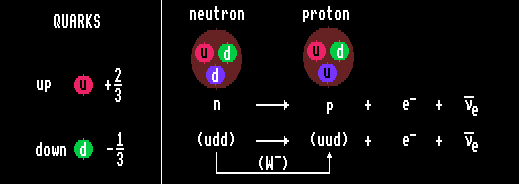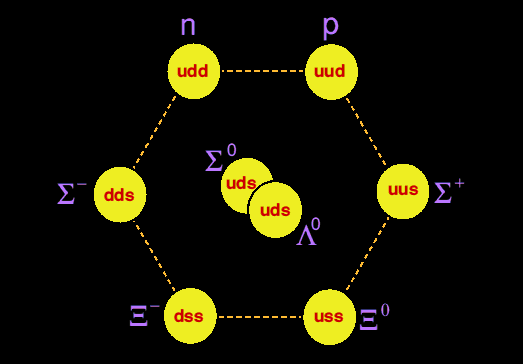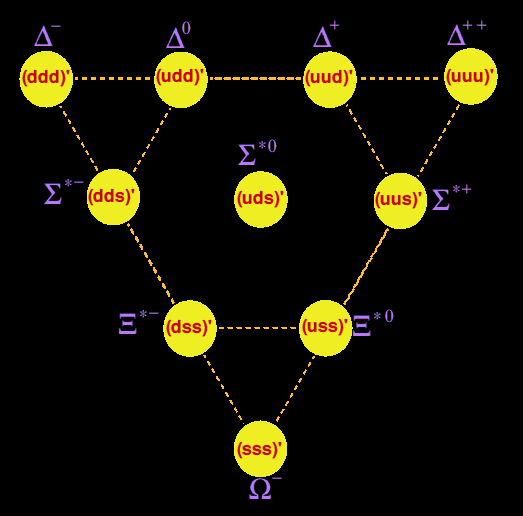

The proton and neutron consist of three quarks from the first generation (up and down quarks). The neutron has one up and two down quarks (which have an electrical charges of +2/3 -1/3 -1/3 making a total of zero), the proton two up and one down quark (+2/3 +2/3 -1/3 = +1). There exists a different baryon for each combination of quarks from the three generations, up, down, strange, charm, bottom and top, all except the proton are unstable. In beta decay, one of the down quarks in a neutron changes into an up quark, producing a proton, the difference in charge between the up (+2/3) and down (-1/3) quark giving the emitted electron unit negative charge. An anti-neutrino is also emitted. In order for a down quark to change into a up quark, sufficient energy must be borrowed to conjure up (from nowhere) a massive W minus particle, the carrier of the electroweak force which transfers a charge of +1 on to the down quark (charge -1/3) transforming it into an up quark (charge +2/3), at the same time creating an anti-neutrino and an electron from the remaining charge of -1. Because a massive energy can only be borrowed for a very short time, the probability of beta decay is very small.

The above diagram shows all spin-½ baryons of the SU(3) sub-group. Here two of the quarks have paired-off (anti-parallel) spins, leaving the third un-paired; leaving a net spin is ½. The familiar neutron and proton are at the top of the diagram. Note that there are two different baryons at the centre, both with an uds complement of quarks, the Lambda-naught and the Sigma-naught particles.. Notice the symmetry of the electrical charges, with positive being top and rightish, neutral being a middle diagonal, and negative being bottom and leftish. Note also the symmetry of s-quarks, none on the top row, one in the middle row, and two in the bottom row. Note that baryons with spin-½ and all one flavour of quark (uuu, ddd, or sss) are prohibited because one must then have the same quantum numbers, which is forbidden for the (fermionic) quarks.
Note that the hexagonal structure has no existence; it is just a way of grouping the baryons into some sort of rational order, like the periodic table of the elements.

The above diagram shows all spin-3/2 baryons of the SU(3) sub-group. Here all the quarks have the same spin, producing a net spin of 3/2. Thus these are excited versions of the above spin-½ baryons. Notice the symmetry of the electrical charges, with double positive being top right, with single positive being top and rightish, neutral being a middle diagonal, and negative being bottom and leftish. Note also the symmetry of s-quarks, none on the top row, one in the middle row, and two in the next lower row and three in the bottom 'row': the famous omega-minus particle which is triply strange. Note that this time there is only one baryon in the centre, the Sigma-star-naught meson..
Naturally, there are many more baryons if one includes the charm, top and bottom quarks as well.
RATIO of BARYONS, DARK MATTER & DARK ENERGY in the UNIVERSE
The matter that we can see in the Universe consists of baryons. But the baryons in the Universe account for just 4.6% of the mass of the known Universe. No one knows what form the missing 95.4% of the mass of the Universe consists of, but they have called it 'dark matter' and 'dark energy'. Whatever dark energy and dark matter is, it does not consist of any of the known forms of matter or energy. And of the 4% of mass that is baryons, we can 'observe' only half of it, the rest appears 'invisible' to us, it could be locked up in black holes, or it could be dispersed very finely in space. Some think that this 2% is contained as a tenuous gas within the strings of an intergalactic web criss-crossing the Universe like a birds nest. The web itself may be made of dark matter and/or dark energy. See Virtual Particle Pairs. In 2004 mathematicians discovered that by changing one of the terms in Einsteins General Relativity, they could account for Dark Energy, Dark Matter and Inflation all in one swoop, the Ghost Condensate.
![]()
![]()